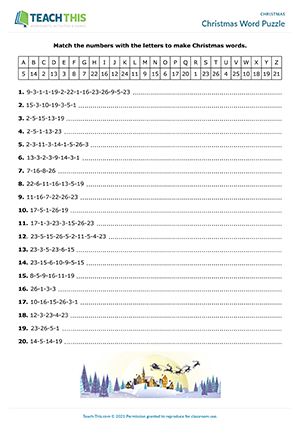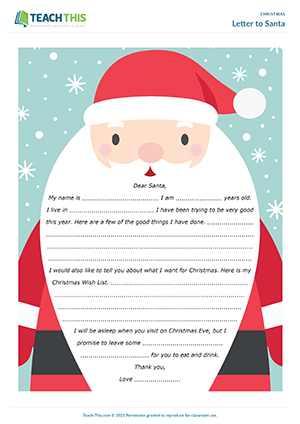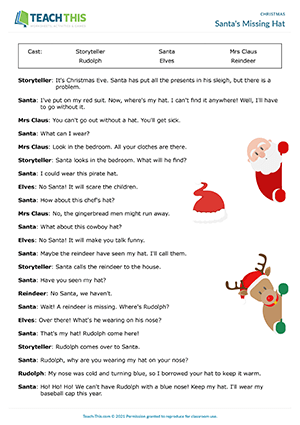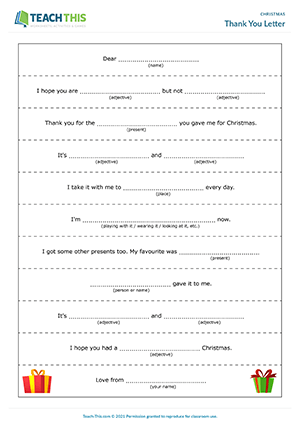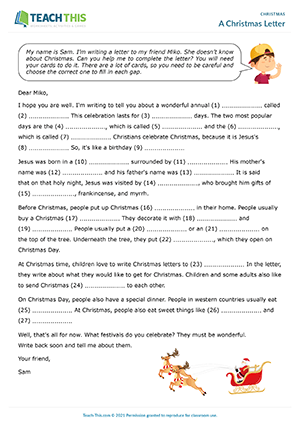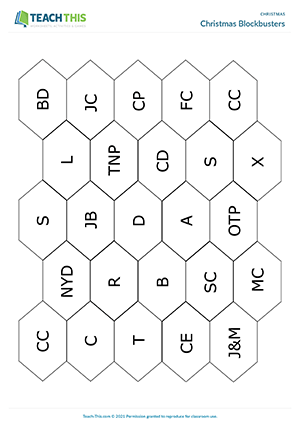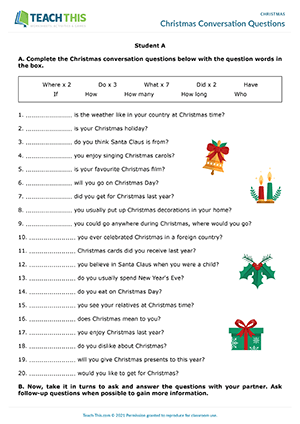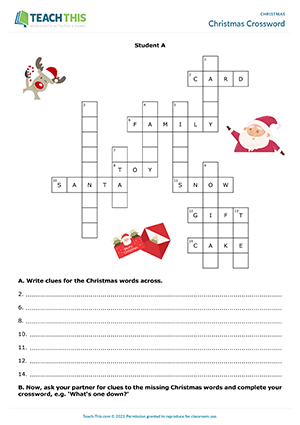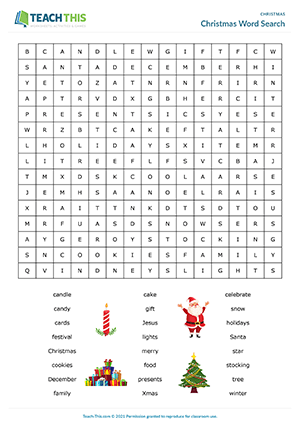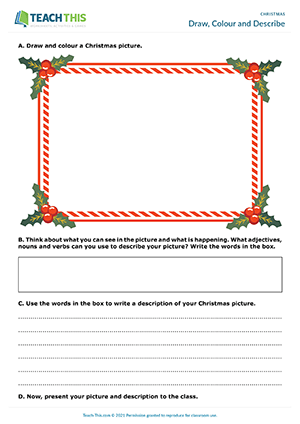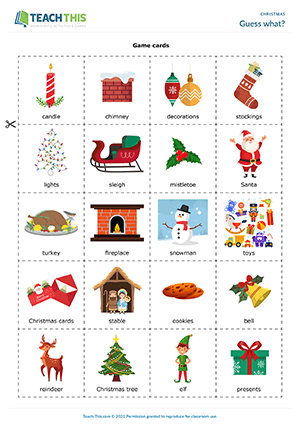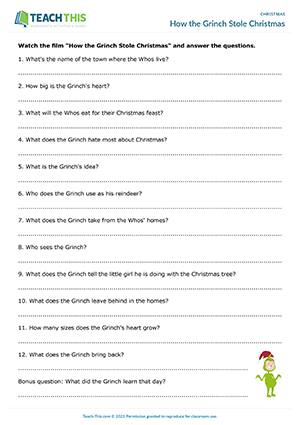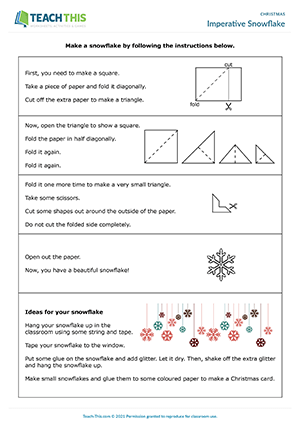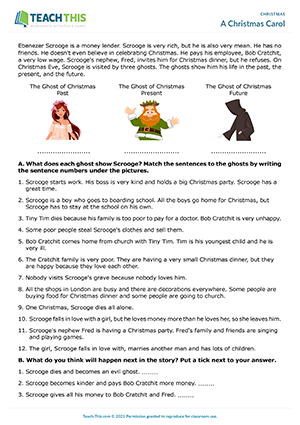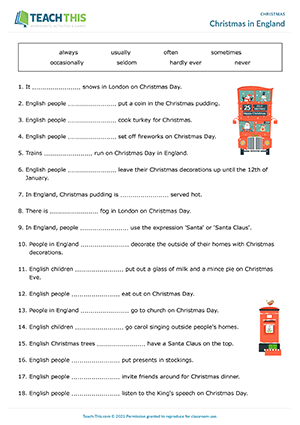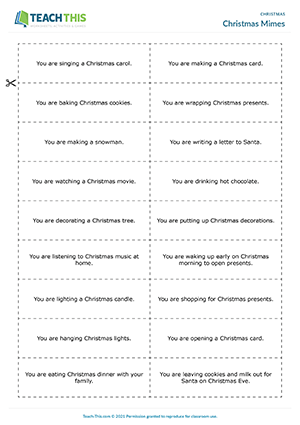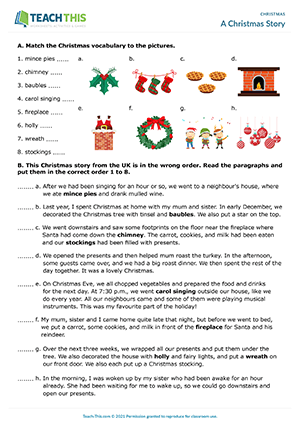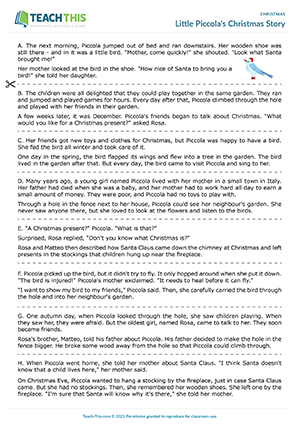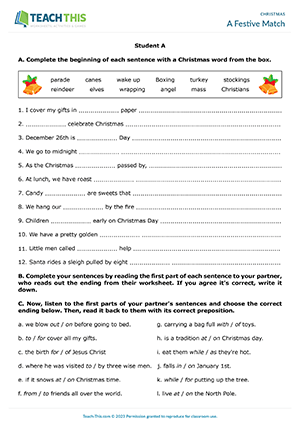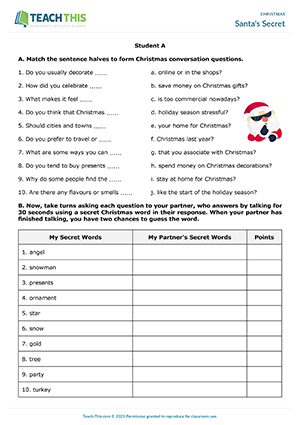In this free Christmas vocabulary worksheet, students race to write down 20 Christmas words by matching numbers to letters. Students look at the numbers for each word and find the corresponding letters in a chart on the worksheet. Students then write the Christmas word in the space provided. The first student to complete the worksheet correctly wins. Afterwards, review the correct answers and meaning of each Christmas word with the class.
Here is an enjoyable Christmas worksheet for young learners. In the activity, students complete a letter to Santa Claus, telling Santa about the good things they have done this year and the presents they want for Christmas. Students begin by completing the letter with their name, age and location. Students then go on to write about the good things they have done this year and why they deserve a present. After that, students tell Santa what they would like for Christmas by creating a Christmas wish list. When the students have finished, they read their letters to the class. The letters can then be displayed around the classroom or sent to the North Pole.
In this interesting Christmas role-play activity, students perform a short Christmas play and answer comprehension questions about it. Assign each student a role in the play. Students then practice the script in their groups. Students rehearse the play several times and practice acting out the various scenes. When the groups are ready, they take turns acting out the play in front of the class. As the other students watch the play, they answer comprehension questions based on the story. When the groups have finished performing, check the answers with the class and then have the students draw a scene from the play.
In this fun Christmas activity, students write thank you letters for Christmas presents by completing sentences in a chain format. This is a light-hearted activity and students should be encouraged to be as imaginative or amusing as they like by completing the letters with the names of famous people, unusual Christmas presents, funny adjectives, etc. To begin, students complete the salutation, e.g. 'Dear Batman'. Students then fold the letter along the dotted line and pass it to the person on their right who completes the next sentence, folding and passing the paper as before. This process is repeated until all the sentences have been completed. Students then open the letter and read it aloud to the group. The letters should make an entertaining read.
This engaging Christmas game can be used to teach Christmas vocabulary and traditions. In the game, students race to provide words in order to complete a Christmas letter. Start by reading the letter to the class using the word 'blank' for each missing word. When a missing word comes up, students look at their cards to see if they have a suitable Christmas word to complete the sentence. The first student to hold up the correct picture card and say the word scores a point for their team. The team with the most points at the end of the game wins. Afterwards, students put all their team's cards together face up on the table and complete the letter for themselves. As an extension, students write a reply to the letter where they talk about the festivals they celebrate. These letters can be read aloud or displayed around the classroom. Students can also play a categorizing game, pelmanism game or game of 'Snap' with the cards.
In this rewarding Christmas game, students guess vocabulary related to Christmas from quiz questions and clues given by the teacher. The aim of the game is to connect the hexagons from one side of the grid to the other. This is a fairly strategic game and students need to choose their moves carefully in order to win, blocking the other team when necessary. The game starts with the center hexagon. Give the clue or quiz question for the letter in the hexagon (D), e.g. 'What do people put up in their home at Christmas time?' The two teams then race to answer, i.e. decorations. The first team to answer correctly wins the hexagon and it is coloured accordingly. The winning team then chooses the next hexagon. Give the quiz question or clue for the letter or letters in that hexagon and both teams race to answer as before. The first team to connect their hexagons from top to bottom or left to right wins the game.
In this free Christmas speaking activity, students complete Christmas questions with question words and then ask and answer the questions with a partner. In two groups, students use question words in a box on the worksheet to complete a set of Christmas conversation questions. Students then pair up with someone from the other group and take it in turns to ask and answer the questions with their partner. When everyone has finished, students give feedback to the class on what they found out.
In this useful Christmas crossword activity, students complete a crossword by defining and guessing Christmas vocabulary. In two groups, students invent and write down clues for the Christmas words written on their crossword. Students then pair up with someone from the other group and take it in turns to ask their partner for a clue to one of their missing words. Their partner reads out the clue for that Christmas word and the other student tries to guess what it is. If the student guesses the word successfully, they write it on their crossword. If not, their partner continues to give more clues until the student is able to guess the word. Afterwards, students check their spelling by comparing crosswords.
In this creative Christmas word search and game, students find Christmas vocabulary in a word search and then use the words in sentences. First, students look for the Christmas vocabulary shown on the worksheet in the word search and tick the words off as they find them. When the students have finished, review the position and meaning of each Christmas word with the class. Next, put students in teams and call out a Christmas word at random from the word search. The first student to put up their hand and make an appropriate sentence with the word scores a point for their team. The team with the most points at the end of the game wins.
In this imaginative Christmas worksheet, students draw, colour and describe Christmas pictures. To begin, students draw and colour a Christmas picture. Students then think about what they can see in the picture and what is happening. Next, students write adjectives, nouns and verbs they can use to describe their picture and write them in a box on the worksheet. After that, students use the words to write a description of their Christmas picture. Finally, students present their pictures and descriptions to the class.
In this entertaining Christmas game, students ask yes/no questions in order to guess words related to Christmas. In groups, students take it in turns to pick up a card and look at the Christmas vocabulary shown on the card. The other students then take it in turns to ask one yes/no question to the student using a game sheet to help them, e.g. 'Is it green?' As the student with the card answers each question, students eliminate vocabulary from the game sheet that doesn't apply. When a student thinks they know the answer, they wait until their turn to make their guess, e.g. 'Is it mistletoe?' If the student guesses correctly, they score a point. The student with the most points at the end of the game is the winner.
In this handy Christmas worksheet, students answer comprehension questions about the film "How the Grinch Stole Christmas." Students watch the film and answer the comprehension questions on the worksheet. When the film is over, check the answers with the class.
Here is a practical Christmas activity to help decorate the classroom for Christmas. Working alone, students read the instructions on the worksheet and make a snowflake using paper and scissors. Students then use the snowflakes to decorate the classroom by hanging them up or taping them to the window. As an extension, students make small snowflakes and glue them to some coloured paper to make a Christmas card.
This Christmas worksheet is based on the story "A Christmas Carol" by Charles Dickens. The worksheet can be used to check the students' comprehension of the film. Students begin by reading an introduction to the story. Students then watch the short film "A Christmas Carol." As the students are watching the film, they match the sentences on the worksheet to each ghost, according to the things that each ghost shows Scrooge. When all three ghosts have visited Scrooge, stop the film and check the answers with the class. Students then predict what will happen next. Students then continue watching to check to see if their predictions were correct.
In this insightful Christmas game, students learn about English Christmas traditions by completing sentences with adverbs of frequency. Read out the first sentence about Christmas in England from the worksheet. Teams then guess the missing adverb of frequency in the sentence. Teams that want to guess the adverb of frequency without a clue give their answers first. Teams that are unsure of the correct answer ask for a clue. Teams score five points if they guess correctly without a clue and two points if they guess correctly after a clue has been given. The next sentence is then read out to the class and so on. The team with the highest score at the end of the game wins.
This free Christmas game can be used to teach or review common Christmas traditions and activities as well as the present continuous tense. The aim of the game is to guess what Christmas traditions or activities students are doing from mimes. A student from one team comes to the front of the class and is given a mime card. The student then asks the class 'What am I doing?' and performs the mime on the card. When a member of either team thinks they know what Christmas tradition or activity the student is doing, they call out their answer by making a present continuous sentence, e.g. 'You are singing a Christmas carol'. The first student to correctly guess the sentence scores a point for their team. A student from the other team then comes to the front of the class and so on. The team with the most points at the end of the game wins.
This productive Christmas worksheet helps students learn about Christmas traditions and practice narrative tenses. Students begin by matching Christmas vocabulary from a story they are going to read to pictures. Students then read paragraphs from the Christmas story and put them in the correct order 1 to 8. Next, students answer comprehension questions based on the story. After that, students find examples of narrative tenses in the story. Finally, students write a short story about a celebration they have had using narrative tenses. When the students have finished, they read their stories to the class.
In this comprehensive Christmas worksheet, students read a Christmas story and complete exercises based on the text. First, in pairs, students read a set of story strips and put them in the correct order. Students then read the Christmas story together to check the correct order. Next, students answer comprehension questions about the main details of the story and identify words used for dialogue. After that, students write from the point of view of one of the characters in the story, describing what happened. Finally, students read their points of view of what happened in the story to the class.
Here is an intriguing Christmas vocabulary activity to help students practice words related to Christmas and Christmas traditions. Working alone, students complete the beginning of each sentence with a Christmas word from a box. Student A then starts by reading out the beginning part of their first sentence to Student B, who listens and chooses suitable ending from their worksheet. Student B then reads out the second part of the sentence with its correct preposition. If the other student agrees it is correct, they write it down. If not, Student B reads other possible endings to find the right one. When Student A has completed all their sentences, the two students swap roles. Afterwards, review the correct answers and Christmas vocabulary and traditions with the class.
In this fun Christmas vocabulary guessing game, students answer Christmas questions and hide a secret word in their responses for a partner to guess. In two groups, students begin by matching sentence halves to form Christmas conversation questions. Next, students pair up with someone from the other group and take turns asking each question to their partner, who answers by talking for 30 seconds using a corresponding secret word somewhere in their response. When their partner has finished talking, the other student has two chances to guess the hidden word. If the student guesses correctly on the first try, they score two points. If they guess correctly on the second try, they get one point. If the student doesn't guess correctly, their partner reveals the answer, and no points are awarded. The student with the most points at the end of the game wins.
Latest Free
Resources
- Everyday Objects Bingo
Everyday Objects
Elementary (A1-A2)
- Action Verb Races
Actions
Elementary (A1-A2)
- Birthday Basics
Birthdays
Elementary (A1-A2)
- Sales Phrasal Verbs
Business Phrasal Verbs
Upper-intermediate (B2)
Latest Member
Resources
- Collocations at Work
Business Collocations
Intermediate (B1)
- Etiquette Trivia Board Game
Etiquette and Manners
Upper-intermediate (B2)
- Everyday Objects Vocabulary
Everyday Objects
Pre-intermediate (A2)
- Let's have a talk
Verb-Noun Collocations
Pre-intermediate (A2)



